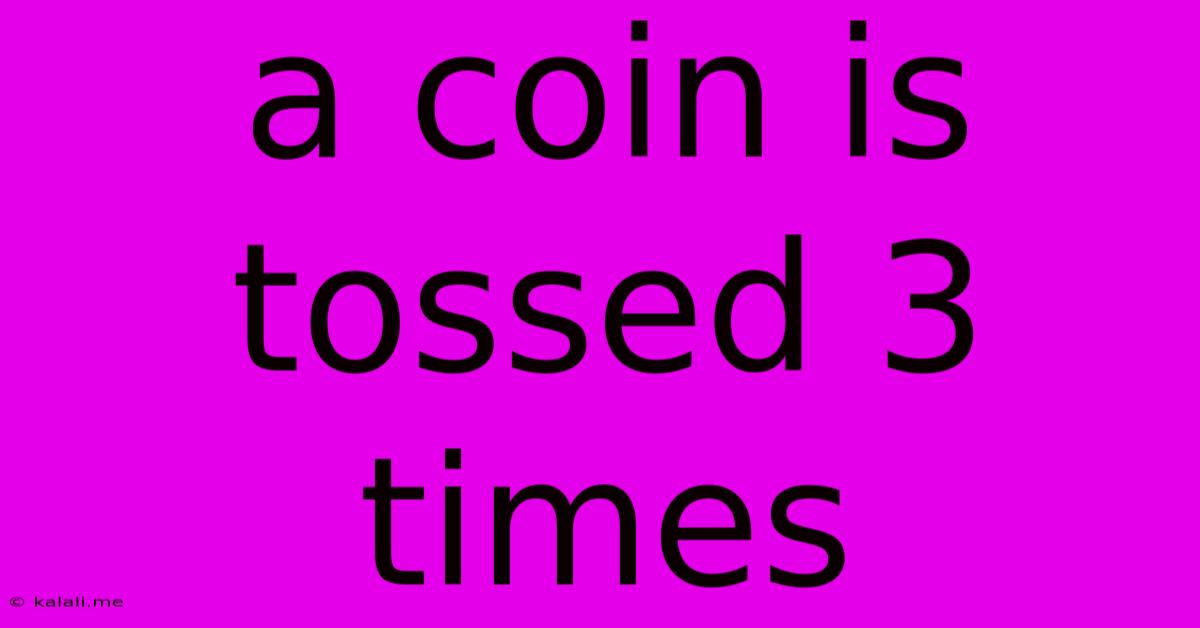A Coin Is Tossed 3 Times
Kalali
Jun 13, 2025 · 3 min read

Table of Contents
A Coin is Tossed 3 Times: Exploring Probability and Outcomes
This article explores the seemingly simple act of tossing a coin three times, revealing the underlying principles of probability and demonstrating how to calculate the likelihood of different outcomes. Understanding this basic scenario provides a solid foundation for tackling more complex probability problems. We'll cover everything from listing all possible outcomes to calculating the probability of specific events, including getting three heads in a row or at least one tail.
Understanding the Sample Space
When you toss a coin once, there are two equally likely outcomes: heads (H) or tails (T). When we toss it three times, the number of possible outcomes increases significantly. To visualize this, let's create a sample space – a list of all possible sequences of heads and tails:
- HHH
- HHT
- HTH
- HTT
- THH
- THT
- TTH
- TTT
There are a total of 8 possible outcomes (2 x 2 x 2 = 2³). This illustrates the fundamental principle of counting outcomes in probability: for each independent event (coin toss), you multiply the number of possibilities.
Calculating Probabilities
Probability is expressed as a number between 0 and 1, where 0 represents impossibility and 1 represents certainty. To calculate the probability of a specific event, we use the following formula:
Probability (Event) = (Number of Favorable Outcomes) / (Total Number of Possible Outcomes)
Let's apply this to some examples:
1. Probability of getting three heads (HHH):
There is only one outcome with three heads (HHH). Therefore:
Probability (HHH) = 1/8 = 0.125 or 12.5%
2. Probability of getting at least one tail:
This is easier to calculate by finding the complement – the probability of not getting at least one tail (meaning getting all heads). We already know the probability of getting all heads is 1/8. Therefore, the probability of getting at least one tail is:
Probability (At least one tail) = 1 - Probability (HHH) = 1 - 1/8 = 7/8 = 0.875 or 87.5%
3. Probability of getting exactly two heads:
Looking at our sample space, there are three outcomes with exactly two heads: HHT, HTH, and THH. Therefore:
Probability (Exactly two heads) = 3/8 = 0.375 or 37.5%
Beyond the Basics: Exploring More Complex Scenarios
The three coin toss example serves as a building block for understanding more complex probability scenarios involving multiple independent events. The same principles can be applied to situations with more coins, dice rolls, or other random events. Key concepts like independent events, mutually exclusive events, and conditional probability all build upon this foundational understanding.
Applications in Real-World Situations
While tossing coins might seem trivial, the principles of probability demonstrated here have widespread applications. From analyzing market trends in finance to determining the likelihood of disease transmission in epidemiology, understanding probability is crucial in numerous fields. Mastering the basics with simple examples like this three-coin toss provides a strong foundation for tackling more complex real-world challenges.
Conclusion:
This exploration of the three coin toss experiment illustrates the core concepts of probability. By understanding how to calculate the sample space and apply the probability formula, we can confidently determine the likelihood of various outcomes. This foundational knowledge is essential for further studies in probability and its diverse applications across various fields.
Latest Posts
Latest Posts
-
Which Cycle Is Not A Major Biogeochemical Cycle
Jun 14, 2025
-
Good Conductor Of Heat And Electricity Metal Or Non Metal
Jun 14, 2025
-
Which Of The Following Statements About Interjections Is False
Jun 14, 2025
-
What Is The Lcm Of 2 And 11
Jun 14, 2025
-
How Are Protists And Bacteria Different
Jun 14, 2025
Related Post
Thank you for visiting our website which covers about A Coin Is Tossed 3 Times . We hope the information provided has been useful to you. Feel free to contact us if you have any questions or need further assistance. See you next time and don't miss to bookmark.